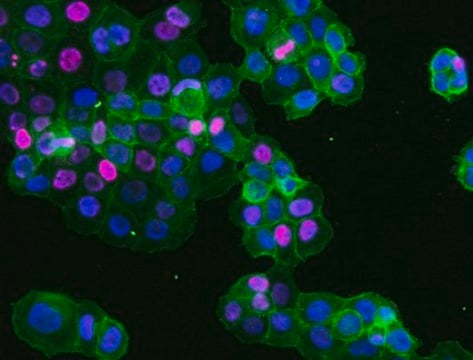We have not tested the product in the above mentioned application. The product has been tested to be suitable for a variety of biological samples (e.g., plasma, serum, urine, tissue, and culture media.) or food/beverage samples (e.g., wine, coffee, and juice). The cell pellet may not be suitable. To discuss this further, we kindly ask you to navigate to the link https://www.sigmaaldrich.com/techservice, click on "Report Product Issues" under the Products Section with all the required information so that a member of our team can reach out to you to assist further. Thank you.
MAK321
Acetaldehyde Assay Kit
sufficient for 100 fluorometric tests
Synonyme(s) :
Acetaldehyde Quantitation Kit
About This Item
Produits recommandés
Utilisation
sufficient for 100 fluorometric tests
Entrée
culture(s)
food(s)
serum
plasma
tissue
urine
beverage(s)
Application(s)
cosmetics
food and beverages
Méthode de détection
fluorometric
Maladie(s) pertinente(s)
gastrointestinal diseases
Température de stockage
−20°C
Catégories apparentées
Description générale
Application
- Food and Beverage Testing
- Gastrointestinal Disease Research
Caractéristiques et avantages
Simplified Process: Experience a streamlined process with the addition of only a single working reagent and a 30 minute room temperature reaction, reducing complexity and saving valuable time and effort.
Compatibility with High-Throughput Systems: Easily incorporate our kit into high-throughput handling systems, ensuring smooth and accurate processing, enhancing efficiency in your laboratory workflow.
Adéquation
Principe
Autres remarques
Mention d'avertissement
Danger
Mentions de danger
Classification des risques
Eye Dam. 1 - Met. Corr. 1 - Skin Corr. 1B
Code de la classe de stockage
8A - Combustible corrosive hazardous materials
Faites votre choix parmi les versions les plus récentes :
Certificats d'analyse (COA)
Vous ne trouvez pas la bonne version ?
Si vous avez besoin d'une version particulière, vous pouvez rechercher un certificat spécifique par le numéro de lot.
Déjà en possession de ce produit ?
Retrouvez la documentation relative aux produits que vous avez récemment achetés dans la Bibliothèque de documents.
-
Hi, I want to ask a question regarding the fluorometric acetaldehyde assay kit (MAK321). Is it suitable for determining acetaldehyde levels in cell culture pellets, and what is the detection range if cell culture supernatant is used?
1 answer-
Helpful?
-
Active Filters
Notre équipe de scientifiques dispose d'une expérience dans tous les secteurs de la recherche, notamment en sciences de la vie, science des matériaux, synthèse chimique, chromatographie, analyse et dans de nombreux autres domaines..
Contacter notre Service technique



